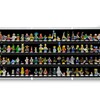Coating of Plastic Parts: Enhancing Performance, Durability, and Aesthetics
Plastic components are used extensively in industries such as automotive, consumer electronics, medical devices, and home appliances due to their lightweight, corrosion resistance, and cost-effectiveness. However, raw plastic surfaces often lack the durability, appearance, or functionality required for advanced applications. That’s where Coating Of Plastic Parts becomes essential.
From protective finishes to decorative layers and functional coatings like EMI shielding, professional plastic coating techniques improve the surface properties of plastic parts — extending their life, improving performance, and enhancing visual appeal.
This article provides an in-depth look at plastic part coating processes, materials, applications, and industry standards.
- Why Coat Plastic Parts?
Coating Of Plastic Part is far more than just an aesthetic enhancement — it’s a critical process that adds performance, durability, and functionality. Whether you need scratch resistance for consumer electronics, metallic finishes for auto interiors, or EMI protection in a circuit housing, professional plastic coating services offer tailored solutions for every requirement.
Plastic parts are coated to achieve specific objectives:
✅ Surface Protection
- Improves resistance to wear, UV exposure, chemicals, and moisture
- Prevents discoloration, cracking, or degradation over time
✅ Aesthetic Enhancement
- Adds gloss, matte, metallic, or textured finishes
- Enables branding with color matching, patterns, and decorative effects
✅ Functional Improvements
- Provides electrical conductivity or insulation
- Adds anti-static or anti-bacterial properties
- Improves adhesion for bonding or printing
- Common Coating Methods for Plastic Parts
Different industries and applications demand various coating techniques. Here are the most widely used methods:
2.1 Spray Painting (Wet Painting)
- Applies paint or lacquer using air or airless spray guns.
- Common for automotive interiors, electronics, and appliance covers.
Benefits:
- Wide color and finish options
- Compatible with complex geometries
- Fast and cost-effective for medium to high volumes
2.2 Powder Coating (Specialized for Plastics)
- Involves applying a dry powder that’s heat-cured to form a hard, uniform coating.
- Special low-temperature powders are used for heat-sensitive plastics.
Benefits:
- Excellent durability and uniform coverage
- Environmentally friendly (low VOCs)
- Scratch and impact resistant
2.3 Vacuum Metallizing
- Deposits a thin metallic film (e.g., aluminum) in a vacuum chamber.
- Often topped with a protective clear coat.
Applications:
- Automotive trim, reflectors, cosmetic packaging
- Produces a chrome-like or mirror finish
2.4 Electroplating on Plastic
- Involves a complex process where plastic is first made conductive, then electroplated with metals such as nickel, chrome, or copper.
Used for:
- Automotive emblems, bathroom fixtures, high-end decorative parts
2.5 UV Coating
- A liquid coating that’s instantly cured by ultraviolet light.
- Used to enhance abrasion resistance and add high-gloss finish.
Benefits:
- Fast curing, low VOC
- Excellent clarity and durability
2.6 Dip Coating
- Immerses parts into a coating solution and removes them slowly to create even coatings.
- Often used for protective rubberized or soft-touch finishes.
2.7 Plasma Coating / Plasma Surface Treatment
- Involves modifying the surface of plastics at the molecular level using ionized gas (plasma).
- Prepares surfaces for painting, gluing, or printing.
- Types of Coating Materials
The choice of coating depends on performance requirements and substrate compatibility:
|
Coating Type
|
Properties & Applications
|
|
Acrylic Paints
|
UV-resistant, flexible, used in automotive interiors
|
|
Polyurethane (PU)
|
Tough, chemical-resistant, used in appliances and electronics
|
|
Epoxy Coatings
|
Excellent adhesion and hardness, used in industrial and electrical parts
|
|
Silicone Coatings
|
High heat resistance, used in lighting and aerospace
|
|
Metallic Coatings
|
Chrome-like finish, decorative and functional uses
|
|
Anti-Microbial Coatings
|
Healthcare and medical devices
|
|
EMI Shielding Coatings
|
Electromagnetic interference protection in electronics
|
- Surface Preparation: The Key to Successful Coating
Plastic surfaces require meticulous preparation before coating to ensure proper adhesion and finish:
- Cleaning: Removes oils, dust, and mold release agents
- Sanding or Abrasion: Creates texture for better coating grip
- Flame or Plasma Treatment: Modifies surface energy to improve paint adhesion
- Priming: Special plastic primers ensure bonding between the substrate and topcoat
5. Quality Control and Testing
Coated plastic parts are tested to meet aesthetic and performance standards, including:
- Cross-hatch adhesion test
- Abrasion resistance (Taber test)
- UV/weathering tests
- Chemical resistance
- Gloss level and color accuracy
- EMI shielding effectiveness (for conductive coatings)
6. Applications of Coated Plastic Parts
|
Industry
|
Examples of Coated Components
|
|
Automotive
|
Dashboards, trim, buttons, interior/exterior panels
|
|
Consumer Electronics
|
Smartphone housings, keyboards, speaker grills
|
|
Medical Devices
|
Enclosures, handles, equipment panels
|
|
Appliances
|
Washer/dryer panels, knobs, refrigerator components
|
|
Cosmetics
|
Perfume bottles, caps, compact cases
|
|
Defense/Aerospace
|
Lightweight coated structural or electronic housings
|
7. Environmental & Regulatory Considerations
Modern coating services must comply with environmental and safety standards:
- Low-VOC paints and water-based coatings to reduce emissions
- REACH and RoHS compliance for chemicals in coatings
- Recyclable processes and materials in sustainable manufacturing
Eco-friendly coating solutions are gaining popularity as industries move toward greener manufacturing.
8. Choosing a Plastic Coating Service Provider
When selecting a plastic coating partner, consider the following:
✅ Experience with Your Material
Not all coatings adhere well to every plastic. Choose a provider familiar with materials like ABS, PC, PP, or nylon.
✅ In-House Capabilities
Providers with in-house prep, coating, curing, and testing reduce lead times and increase quality control.
✅ Quality Assurance
Check for ISO 9001 or IATF 16949 certification, and request sample runs or test data.
✅ Coating Options
A range of finishes, textures, and functional coatings ensures flexibility in product development.
Conclusion
Coating of plastic parts is far more than just an aesthetic enhancement — it’s a critical process that adds performance, durability, and functionality. Whether you need scratch resistance for consumer electronics, metallic finishes for auto interiors, or EMI protection in a circuit housing, professional plastic coating services offer tailored solutions for every requirement.
With evolving materials, advanced application technologies, and strict environmental standards, the future of plastic part coating is driven by innovation and precision.



